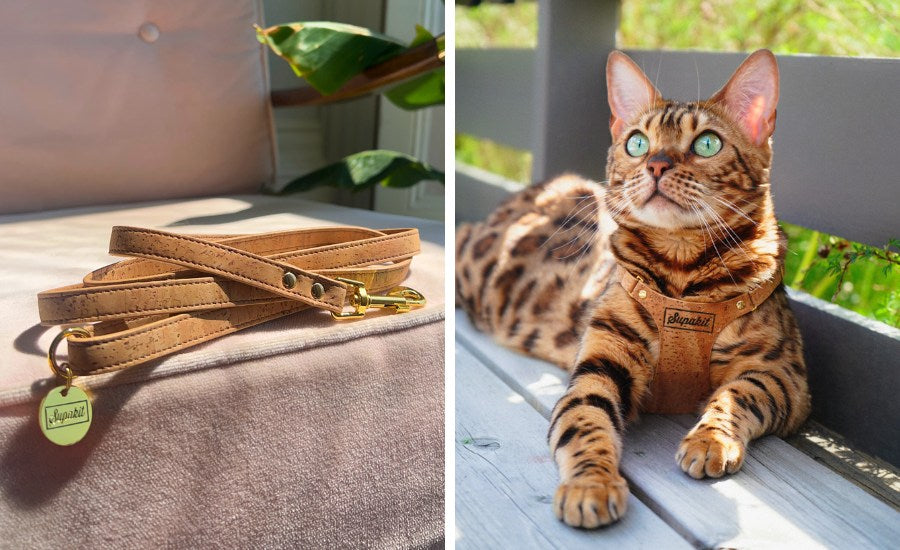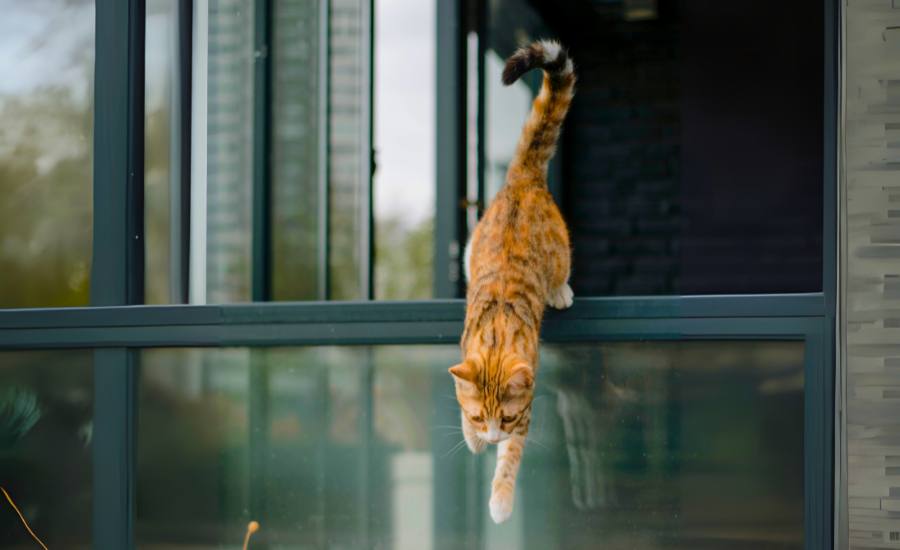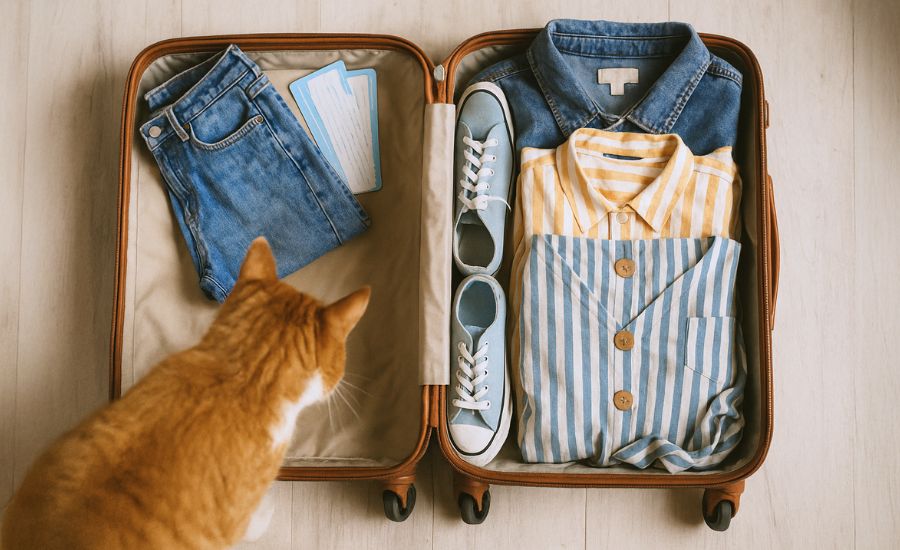Camping With Your Cat

If you’re a fan of the great outdoors, you might have considered sharing it with your cat - but is it possible to go camping with your cat? The good news is the answer is a resounding YES. As someone who camps with their cats (yes, two of them) regularly, it can be a bit tricky to know how best to get started. Let’s take a look at how best to prepare and the important considerations you want to make, before venturing outdoors with your cat.
Why would I take my cat camping?
You may want to take your cat camping for several reasons. If you and your cat enjoy being outdoors, this is a great way to experience it together whilst strengthening your bond, providing environmental diversity for your cat, sensory stimulation and exercise. Also, being able to travel with your cat stops them from being at home pining for you while you're away (having fun), and as a bonus, it’s a great way to save on pet sitting!
Why shouldn't I take my cat camping?
You shouldn’t take your cat camping if they don’t have the necessary training. Training is super important as it will not only help to keep your cat safe, but it will allow them to feel confident and comfortable in a new place too. Your cat should be trained and comfortable to spend time in a pet carrier, backpack or pet pen. If you plan on letting them explore on foot, they should be fully trained in a harness and leash. You may also want to consider training them in recall too which is super handy in unfamiliar and potentially distracting new environments. Having a base of strong, core training is essential before taking your cat to new places.
Sign up for our complete harness training course
Planning your trip:

Things to consider before you head off…
What camping style might best suit my cat?
When it comes to camping, it doesn’t just have to be in a tent at a campsite. You may want to explore other options such as glamping, camping pods or wild camping as a particular style will have its pros and cons. Wild camping offers the benefit of being in a low-traffic, low-footfall area if your cat prefers a more quiet, solitary experience. Alternatively, a glamping pod can offer more comfort and space during ‘downtime’ and is more protected from the elements.
How to find cat-friendly locations
When planning a camping trip, if you intend to stay at a campsite, it is always best to call ahead of your booking to make sure cats are welcome. You may also want to ask for a pitch that is best suited to your cat’s needs (in a quiet spot, away from other animals or children).
The Supakit Cat Map
At Supakit we have a community-sourced map which has locations worldwide that are tried and tested by cat explorers. Why not browse the map for inspiration and find a cat-friendly location near you, or if you know an amazing spot, upload the pin and share it with others?
Related: The Supakit Cat Map
Can you wild camp with a cat?
In some parts of the world, wild camping is permitted and you can do this with your cat. Wild camping is camping outside of campsites or permitted areas and tends to be done in sparsely-populated areas, difficult to access by road. Consider the area you are going to, how you will get there with your cat and what potential dangers/obstacle you may come across in that area. Plan for what you would do in an emergency or if your cat goes missing.
Getting ready for your departure:

It’s time to get excited but remember, prep is key to a smooth camping experience!
Introducing the tent & tent rehearsals
If your cat is new to camping, it can be super helpful to do some groundwork before you venture out in a tent. Cats are most comfortable when they have a place of familiar territory and this is what you’ll want to try and achieve when you're camping with them. The tent (and most likely a backpack and car) should be considered as part of their territory – a place they're super chill inside. So, for example, when they're exploring the tent before heading out, you want them to have plenty of time to scent mark it (e.g. by rubbing their face), to spend time inside it before you transport that piece of their 'territory' out to a campsite. You can do this by gifting your cat the opportunity to explore the tent (or any other camping equipment) at home or in a safe environment they are already familiar with like a garden. Taking the time to do this before going away should make that transition easier for you and your cat.
Related: How To Backpack Train Your Cat
Planning your travel
Planning every element of your trip is a great way to feel more confident about camping with your cat. Consider how you will get to your camping location as you may need to prep your cat for travelling in the car or by bike. If his mode of transport is new to your cat, it can be helpful to introduce them to this gradually before you go.
Related: Biking with cats
Planning your activities
You might be thinking that your cat can be with you 100% of the time but, it’s not always the case especially if your approach to camping is a little go-with-the-flow (like mine!). It can be helpful to pre-plan activities that you know you can do with your cat and consider what you ‘do’ with your cat if they cannot be with you at all times (like if you need to run into a store for extra milk, or use a public restroom). If you plan on visiting any eateries, attractions etc, call ahead and ask about their pet policy.
Meal prep
If your cat has a particular diet, it is important to consider how you can continue this whilst you are camping. For cats that usually eat raw or refrigerated foods, it is important to have a plan in place if their food needs to change during your trip.
Just a little personal insight here – my cats have a 50/50 diet which means that if I need to remove the raw portion of their diet, they are super happy to eat dry (kibble) food. We are also in a habit of occasionally changing their food brand so they are willing to eat most flavours or types of food. I can appreciate that this doesn’t suit every cat or every person but this practice has been great at offering us flexibility when we travel.
Cat-specific camping equipment
Your cat will need their own camping essentials when heading out on a trip. Making a set list of essential items you take each time can be helpful (don’t worry, after one camping trip you’ll soon realise what you NEED and what you don’t). Here are some ideas to get you started…
- Cat playpen/crate – When you are outside of the tent, give your cat a safe and secure place to ‘hang out. Pop-up playpens are a great solution when trying to pack light!
- Leashes of different lengths & ground spikes – Having a couple of different leash options allows you to give your cat more freedom (or less) on your trip. During ‘down time’, a long leash attached to a ground spike can let your cat explore their surroundings. The longer length allows you to adjust it accordingly. The ground spikes can help give you a moveable anchor point for the leash. Remember, keep an eye on your cat at all times - it's important for your cat's safety and also because a tether point will make harness escapes more likely, so you'll need to stay vigilant.
- Extra harnesses and leashes – bringing a spare harness and leash is always a great idea as if one breaks, you have a backup!
- Collar & ID tag – a collar and visible ID will help locate, and reunite you with your cat if it goes missing on your trip. Make sure your contact number is up-to-date before you go. You may also want to use a GPS tracker or AirTag as an extra layer of protection.
- Weather-dependent items – the weather is always changing so check ahead of your trip but be prepared for all weather. Consider items you might need if the weather gets hot (cooling mat, extra water, sun shield, lotion), cold or unexpectedly rainy!
- Removeable LED light – lighting can be low in the evening especially if you are wild-camping (not at a campsite). Removable lights can be added to a harness or leash to help you locate your cat in the dark.
- Portable litter tray – although your cat may be happy to tinkle outside if you have to unexpectedly have to stay inside the tent longer than expected (bad weather). A portable litter tray allows your cat to relieve themselves from the comfort of the tent. This is also super handy during the night and may deter your kitty from waking you up extra early in the morning so they can go potty.
- Pet first aid kit – it is always a good idea to take some sort of first aid kit for your cat as accidents can happen. It may also be helpful to have the contact handy for a nearby vet, just in case. Include some cat-safe suntan lotion, nail clippers and calming spray in your kit too!
- Toys & training equipment – Toys and training are a great way to engage with your cat and entertain them throughout your trip. If you use a clicker, you may want to bring it with you.
Arrival at the campsite:

You made it! Set up and settle down…
Setting up your tent and getting settled
When you get to your camping location, make sure your cat is in a secure place like in their carrier or the car so you can get the tent set up – it can be really helpful to be organized and get everything done whilst your cat is secure.
Make your tent feel like home
Cats typically feel most at home in their territory so there are things you can do to make a tent feel like their home from home. Bring their fave blanket or bedding and a couple of their toys too. Oh, and a portable scratch mat or box can be super handy! Allow them to start using this before your trip.
Routine is always another important element! If you can, keep your cat’s routine as normal as possible when you are camping.
Do a reconnaissance
If your camping location is new to you, do a recce of the area and scope it out. If you are familiar with the area, you’re more prepared. Do this without your cat (if possible), so you can fully concentrate on observing around you. You may also want to take this as an opportunity to meet your ‘neighbours’ and let them know you are camping with a cat.
Related: Dog Encounters
Introduce your cat to the area
When you are settled and familiar with the campsite, allow your cat to do their own recce! Allowing them to explore their new surroundings from the safety of their backpack or on a leash, should help them feel more comfortable.
Bedtime routine
When it comes it hunkering down for the night your cat’s routine should be kept as normal as possible, this way they anticipate bedtime. Give them the chance to relieve themselves one last time (if they go outside). It can also be helpful to make sure that your cat is tired. Tiring them out before bed can help them to have a restful night’s sleep, reducing the chances of 3 am zoomies!
As an extra precaution, double-fasten the tent zippers. Carabiners can be a great way to do this – simply pass one through both zip ends, keeping them secure. This will stop your kitty from trying to make midnight escapes. However, if you secure your zippers, make sure you can still exit the tent safely and quickly in an emergency.
You might also like







